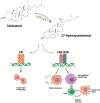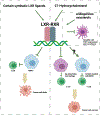Our evolving understanding of how 27-hydroxycholesterol influences cancer
- PMID: 34043965
- PMCID: PMC8611110
- DOI: 10.1016/j.bcp.2021.114621
Our evolving understanding of how 27-hydroxycholesterol influences cancer
Abstract
Cholesterol has been implicated in the pathophysiology and progression of several cancers now, although the mechanisms by which it influences cancer biology are just emerging. Two likely contributing mechanisms are the ability for cholesterol to directly regulate signaling molecules within the membrane, and certain metabolites acting as signaling molecules. One such metabolite is the oxysterol 27-hydroxycholesterol (27HC), which is a primary metabolite of cholesterol synthesized by the enzyme Cytochrome P450 27A1 (CYP27A1). Physiologically, 27HC is involved in the regulation of cholesterol homeostasis and contributes to cholesterol efflux through liver X receptor (LXR) and inhibition of de novo cholesterol synthesis through the insulin-induced proteins (INSIGs). 27HC is also a selective modulator of the estrogen receptors. An increasing number of studies have identified its importance in cancer progression of various origins, especially in breast cancer. In this review, we discuss the physiological roles of 27HC targeting these two nuclear receptors and the subsequent contribution to cancer progression. We describe how 27HC promotes tumor growth directly through cancer-intrinsic factors, and indirectly through its immunomodulatory roles which lead to decreased immune surveillance and increased tumor invasion. This review underscores the importance of the cholesterol metabolic pathway in cancer progression and the potential therapeutic utility of targeting this metabolic pathway.
Copyright © 2021 Elsevier Inc. All rights reserved.
Conflict of interest statement
Conflict of interest: The authors have nothing to declare
Figures


References
-
- Gostynski M, Gutzwiller F, Kuulasmaa K, Doring A, Ferrario M, Grafnetter D, Pajak A, Project WM, Analysis of the relationship between total cholesterol, age, body mass index among males and females in the WHO MONICA Project, Int J Obes Relat Metab Disord, 28 (2004)1082–1090. - PubMed
Publication types
MeSH terms
Substances
Grants and funding
LinkOut - more resources
Full Text Sources
Other Literature Sources
Medical

